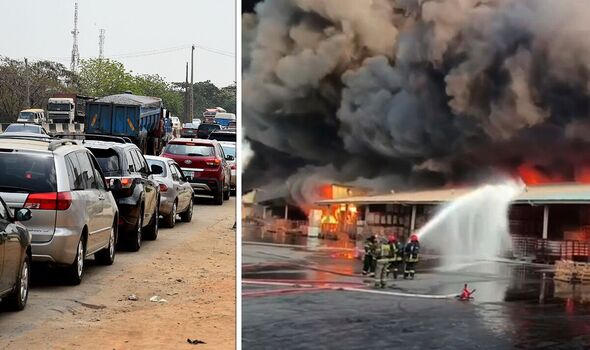World
Russia Faces Fuel Crisis as Petrol Stations Run Dry Amid Attacks

Russia is grappling with a severe fuel crisis as petrol stations across the country run dry, leading to long queues of motorists and the introduction of rationing in multiple regions. This situation has escalated following weeks of Ukrainian drone strikes targeting oil refineries and other critical infrastructure, significantly reducing production and pushing prices to unprecedented levels.
As of late August, wholesale prices for A-95 petrol, the highest octane fuel available, surged to approximately 50% higher than in January, according to the St Petersburg International Mercantile Exchange. This spike in prices coincides with increased demand as farmers urgently seek fuel for harvest operations and many Russian families embark on their last summer holiday trips.
Fuel shortages have been particularly acute in the Far East and on the Crimean Peninsula, which was annexed by Russia in 2014. Reports from local media in the Primorye region indicate that drivers are facing hours of waiting at petrol stations, with prices reaching around 78 roubles per litre (approximately $3.58 per gallon). Some enterprising individuals have attempted to resell petrol online for as much as 220 roubles per litre (about $10.12 per gallon).
In more remote areas, such as the Kurilsky district of the Kuril Islands, sales of lower-octane A-92 petrol have been completely suspended due to shortages. In Crimea, some companies have restricted fuel sales to customers with special coupons or cards, complicating access for the general public.
The current situation is exacerbated by the ongoing conflict with Ukraine. Drone strikes have targeted a “refinery arc,” extending from Ryazan, located south of Moscow, to Volgograd. This region is crucial for both transportation to popular resorts on the Black Sea and for agricultural activities. According to Sergey Vakulenko, a senior fellow at the Carnegie Russia Eurasia Center, these attacks have been increasingly effective, damaging refinery operations without completely destroying them.
Despite the challenges, Russia has not yet experienced a full-scale breakdown in fuel supply. The capital city, Moscow, remains insulated from the crisis due to well-supplied major refineries nearby, including those in Nizhny Novgorod and within the city itself. However, the impact on individual drivers has been noticeable, particularly in regions with fewer refineries and greater transportation challenges.
The war-related disruptions have not only affected petrol supply but have also led to increased demand as more individuals opt to travel by car due to interruptions in Russian air traffic. Additionally, the inflationary environment has reduced profitability for suppliers who typically stock up on petrol early in the year, leading some to refrain from purchasing this season.
Between August 2 and 24, Ukraine reportedly carried out at least 12 drone attacks on Russian oil infrastructure, with the majority targeting the Ryazan–Volgograd area. These strikes have curtailed refinery activity, resulting in a decrease of about 200,000 to 250,000 barrels per day in crude oil intake for processing into petrol and diesel, according to Gary Peach, an oil markets analyst at Energy Intelligence.
Despite these challenges, experts suggest the current petrol shortage is not critical to the overall functioning of the Russian economy. While private consumers may face difficulties, the transportation sector, particularly those relying on diesel fuel—which remains in surplus—continues to operate relatively smoothly. The military, which primarily uses diesel, is also less affected by the petrol shortage.
Nevertheless, there are concerns that the situation could worsen if drone strikes continue to successfully target key refinery equipment. Damage to components such as distillation columns could impede production and necessitate repairs that may be complicated by the need for foreign parts, especially amid existing sanctions.
The petrol crisis is expected to alleviate by late September as demand decreases and routine maintenance at refineries concludes. However, the present circumstances underscore a vulnerability in Russia’s domestic fuel supply, highlighting potential areas for further exploitation as the conflict with Ukraine evolves.
-

 Health3 months ago
Health3 months agoNeurologist Warns Excessive Use of Supplements Can Harm Brain
-

 Health3 months ago
Health3 months agoFiona Phillips’ Husband Shares Heartfelt Update on Her Alzheimer’s Journey
-

 Science2 months ago
Science2 months agoBrian Cox Addresses Claims of Alien Probe in 3I/ATLAS Discovery
-

 Science2 months ago
Science2 months agoNASA Investigates Unusual Comet 3I/ATLAS; New Findings Emerge
-

 Science1 month ago
Science1 month agoScientists Examine 3I/ATLAS: Alien Artifact or Cosmic Oddity?
-

 Entertainment5 months ago
Entertainment5 months agoKerry Katona Discusses Future Baby Plans and Brian McFadden’s Wedding
-

 Science1 month ago
Science1 month agoNASA Investigates Speedy Object 3I/ATLAS, Sparking Speculation
-

 Entertainment4 months ago
Entertainment4 months agoEmmerdale Faces Tension as Dylan and April’s Lives Hang in the Balance
-

 World3 months ago
World3 months agoCole Palmer’s Cryptic Message to Kobbie Mainoo Following Loan Talks
-

 Science1 month ago
Science1 month agoNASA Scientists Explore Origins of 3I/ATLAS, a Fast-Moving Visitor
-

 Entertainment2 months ago
Entertainment2 months agoLewis Cope Addresses Accusations of Dance Training Advantage
-

 Entertainment4 months ago
Entertainment4 months agoMajor Cast Changes at Coronation Street: Exits and Returns in 2025









